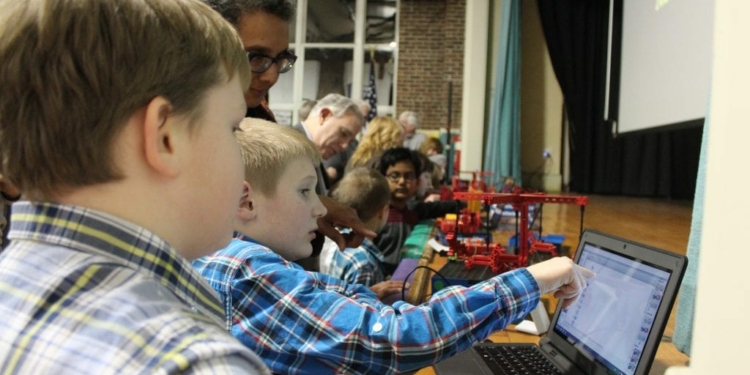Fourth and fifth graders from Elsmere Elementary School on Delaware Ave. showed district officials and parents how to program basic robots at the Jan. 18 Board of Education meeting in the school’s auditorium.

The presentation, requested by board members, highlighted the emphasis the district has placed on STEAM learning — an emphasis meant to prepare young students for jobs in computer programming, engineering and other technology-based careers, jobs for which applicants are expected to be in high demand in coming years. (STEAM education is essentially STEM — Science, Technology, Engineering and Math — with the addition of Art/Design)
“This is a very quickly growing job area,” said Elsmere principal Kate Kloss. “There’s 17 percent expected growth in STEM area jobs versus 10 percent in non-STEM jobs.”
The PTA-sponsored after-school enrichment program, in which students assemble robotics kits and learn computer coding to make them function, was made possible through a donation by community member Paul Wing. Mr. Wing covered the cost of the kits — Studica/fischertechnik academic student software and technology — and laptops as part of a pilot program at Elsmere, and has been instrumental in helping the entire district expand STEAM learning in the elementary schools.
“It’s really great for us to start at the ground level,” said Kloss, pointing out that the program was beneficial in a number of educational areas.
The pilot program consisted of eight one-hour classes attended by 12 fourth and fifth graders — seven boys and five girls — and utilized lego-like kits with wiring that can be animated through a computer coding program. According to the presentation, the class fostered increased creativity, perseverance, cooperation and communication skills, encouraged students to look at how the things around them work and allowed them to utilize their unique strengths. Additionally, the program is meant to help prepare students for future STEAM educational opportunities offered by the district in middle and high school — and beyond.

“Coding is like the language of the computer,” said one young robotics student. “And, like normal languages like Chinese or Japanese, it’s good to learn early on.”
“Robotics and programming are behind everything,” said another. “Everything needs to be engineered by someone. When we were programming the models, it helped to think about how these things really worked.”
“We both hope to be professional coders,” said yet another, of himself and the student standing next to him.
Other students spoke of what they learned, what they enjoyed most, and what setbacks they encountered, as well as how they solved those setbacks.
“They work so hard and they don’t give up,” said fourth grade teacher Greg Balcavage, who volunteered to help with the program. “Where I would get frustrated and take a break, they don’t give up, they just keep working. And that’s a hard thing to teach children.”
According to Kloss, there was so much interest in the program that they had to have a lottery to select participants and have added a third session, expected to begin in late February or early March. Pat Hoogkamp, a parent who claims his wife volunteered him to run attendance during the pilot eight-class session, enjoyed the experience so much that he volunteered to run the current session, as well as the third.

“This whole program worked out just as well as I hoped it would,” said Wing. “It was great to move the STEM activities down into the elementary schools. I’m working now with Heidi Bonacquist at Slingerlands. They’re actually going to incorporate this into the fourth grade curriculum.”
Thanking Wing for his donation, Kloss invited board members and those in attendance to join the students at computers arrayed on the apron of the auditorium stage and, with their help, learn how to program robots.
“It is unbelievable to watch kids’ creativity come to life,” said Balcavage. “They’re better than myself, they’re better than Pat. They just want these things to get up and run.”



